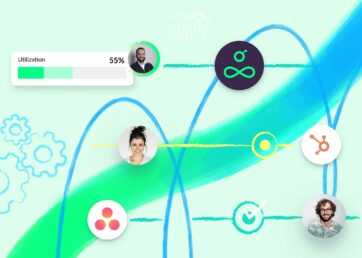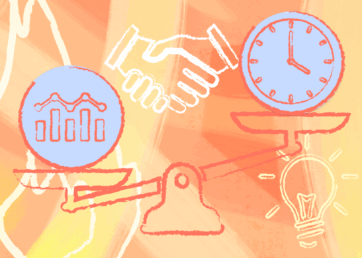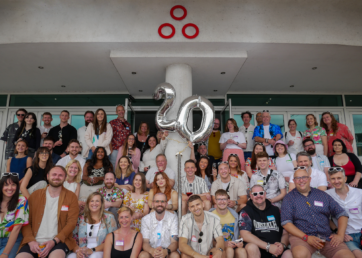Building an agency team structure that is strong, lean, and effective is the first ingredient in your agency’s recipe for success. It’s also a crucial and foundational element to your business, to ensure strong project execution and results.
In this article 📖
What is an agency structure?
An agency team structure, or agency org structure, represents the hierarchical system where roles and responsibilities are well-defined between departments and employees.
Traditionally, this structure is often characterized by a chain of command, with decision-making authority flowing top-down.
But there are plenty of ways to approach the structure of an agency, and we’ll touch on them further in this article.
The importance of your agency team structure
The agency team structure plays a crucial role in determining the effectiveness, efficiency, and overall success of an agency, no matter what type of agency you’re running.
Here are some benefits of defining your agency team structure:
- Clear roles and responsibilities: An agency team structure first and foremost ensures that each team member has clear roles and responsibilities. This helps avoid confusion, duplication of efforts, and miscommunication. When everyone knows their specific responsibilities and exactly how they fit into the overall agency team structure, it also improves productivity, collaboration, as well as ownership.
- Efficient workflow and resource allocation: A structured team hierarchy enables efficient workflow planning and resource allocation. It allows agency project managers to assign tasks, allocate resources, and coordinate work effectively. By having a clear understanding of the team structure, project managers can identify the appropriate individuals to handle specific tasks, distribute the workload evenly, and optimize resource utilization.
- Effective decision-making: When you have defined roles and reporting lines, there will be no confusion around decision-making and authority. This empowers team members to make decisions within their areas of responsibility, and speeds up the decision-making process. Plus, you’ll be able to respond to client needs faster.
- Collaboration and communication: A clear team structure facilitates effective collaboration and communication within the agency. Clear reporting lines and communication channels enable information to flow between teams and improve coordination between team members, departments, and stakeholders.
- Specialization and expertise: By organizing teams based on skill sets (such as creative, strategy, account management, or technical expertise), agencies can leverage the strengths of multiple departments, as well as teams within those departments. Plus, it makes it easy to identify individual team members with specific skill sets and schedule them for the right projects.
- Scalability and growth: An agency team structure that supports scalability and growth is the key to long-term success (we’ll talk more about this later on). It allows agency operations to scale by adding new team members, creating specialized teams, or expanding service offerings. A scalable team structure ensures that the agency can adapt to increased project volumes, evolving client demands, and changing market dynamics without sacrificing efficiency or quality.
- Career progression and talent development: A well-structured team provides opportunities for career progression. On top of this, it adds a transparent agency org chart and hierarchy, so your team members are able to see a clear growth path within the agency. This creates motivation and incentives for professional development within the agency. After all, employee retention is good for business.
- Client satisfaction: Any seasoned agency president or owner knows that a sound team structure directly impacts client satisfaction (which therefore directly impacts your agency’s bottom line). A strategic team structure is what ensures that client needs are effectively communicated, projects are delivered on time and within budget, and client expectations are met.

An example of what assembling a team for a brand refresh could look like.
The 6 most common agency company structures
When it comes to agency organizational structures, there are plenty to choose from. The specific design and characteristics of an agency structure can vary depending on the company size, goals, industry, and culture.
Here’s an overview of the most common agency structures:
3 ways to optimize your agency team structure for growth
When it comes to the organizational structure of an agency, there’s plenty to consider before you establish a model that works for you. But when it comes to optimizing it for growth, these are three crucial elements you can’t ignore:
- Evaluate and align roles: Make a habit out of assessing the roles and responsibilities within your agency team structure on a regular basis. Ensure that they’re aligned with your current growth strategy, while allowing for flexibility further down the road. Make sure to identify any overlaps or gaps in responsibilities and make adjustments accordingly to optimize efficiency and clarity.
- Implement scalable tools: Invest in scalable project management software and resource management tools that can grow alongside your agency. Choose tools that support collaboration, communication, and workflow management. But more importantly, choose tools that your teams want to use.
- Regularly review and adapt: Review your agency team structure, processes, and performance regularly. When you do so, gather feedback from team members, clients, and stakeholders to identify areas for optimization. Be open to making adjustments and adapting your team structure based on the evolving needs of your business as well as market dynamics.
3 agency structure examples
When talking about agency structures, you don’t want to get stuck on “type”. It’s much more complex than that.
The “best” agency structure depends on factors such as agency size, client base, service offerings, and strategic goals.
We’ll take a closer look at examples of agency structure approaches for different agency types below. Use these as inspiration only, and do what’s best for your specific agency situation.
Structure of an advertising agency: Scale with squads

Scale your agency with squads.
If your advertising agency is growing in headcount, you might want to take a note from Saatchi & Saatchi.
When winning both John Lewis and Waitrose, Managing Director at Saatchi & Saatchi, Sarah Jenkins, told The Drum that using a squad system allows them to scale fast.
“It’s contained and scaled at the same time. You’ve got all the years of leadership and energy of our executive crew. But then you’ve got some incredible people actually running their accounts,” she explained.
Digital agency structure: Think about flexibility
Digital marketing agencies are plenty, and the options when it comes to your digital agency organizational structure are just as many.
Again, the digital agency team structure will vary greatly depending on your agency’s size and service offerings.
For example, you may want to maintain a flexible structure to tailor teams to fit specific client projects or campaigns.
Here’s an example of what your digital agency structure might look like:
Core team
The core team includes essential roles that provide foundational support and continuity across all projects. This team is responsible for agency-wide functions and ensures consistent quality and client relationships.
- Account managers: Serve as the primary point of contact for clients, understanding their needs, and managing overall project coordination.
- Project managers: Oversee project timelines, budgets, and resources, ensuring projects are delivered on time and within scope.
- Traffic managers: Oversee resource allocation, project scheduling, and resource constraints.
- Strategists: Develop overarching campaign strategies and ensure alignment with client objectives.
- Creative directors: Provide creative direction and oversee the agency’s creative output.
- Finance and administration: Handle financial aspects, including budgeting, invoicing, and administrative support.
Specialized teams
Specialized teams or “spokes” are units with specific expertise in various digital marketing disciplines. These teams can be assembled or disbanded based on project requirements.
- SEO team: Experts in search engine optimization who work on improving organic visibility.
- Content: Writers, editors, and content strategists responsible for content creation and distribution.
- Paid media: Specialized in paid media, focusing on campaigns like Google Ads and social media advertising.
- Social media: Managing social media strategies and campaigns across various platforms.
- Web development: Handling web design, development, and maintenance.
- Design and creative: Responsible for graphic design, branding, and visual assets.
- Data and analytics: Data analysts and researchers who provide insights and reporting.
- Email marketing: Specialists in email marketing strategy and execution.
Project teams
Project teams are assembled for specific client projects or campaigns, drawing members from both the core team and creative teams as needed.
- Project leads: Assigned from the core team (e.g., account managers or strategists) to oversee project-specific teams.
- Team members: Include specialists chosen from the core and specialized teams based on project requirements.
- Cross-functional collaboration: Project-based teams collaborate to execute the campaign, combining their expertise to achieve client objectives.
With a flexible digital agency company structure you can be more agile when taking on specific clients or projects, adjusting as needed.
Creative agency structure: Make the most of mergers
The advertising world was turned upside down as a result of Covid back in 2020, and is still suffering from the consequences, leaving creative agency organizational structures up for debate.
Matt Seiler, Managing Director at industry talent firm Raines International and a former CEO of IPG Mediabrands told Ad Age that “Every agency I know is mired in restructurings.”
To complicate things further, agencies everywhere are merging. The most recent being Wunderman Thompson and VMLY&R (all while causing an uproar over the new name, VML).
So what exactly does this mean for creative agency team structures? Well, first of all, an organizational strategy is essential for a successful merger. You’ll want to:
- Carry out an audit
- Establish an integration team
- Create multiple solutions and scenarios
Ultimately, you want to choose a structure that optimizes both your talent and resources, while establishing a structure keeps client retention top of mind.
Agency team structure: 10 roles you’ll find in a top-performing project team
We’ve touched on some of these roles already. Let’s take a look at the full list of key agency project team roles and their main responsibilities.
- Project Sponsor: A sponsor is usually a member of senior management. Their main goal is to oversee project operations from a high level and clear any obstacles that threaten project success.
- Project Manager: The project manager is responsible for overall project planning, execution, and delivery. They coordinate resources, manage timelines, and ensure project objectives are met. They act as the primary point of contact for clients, manage client relationships, and ensure client satisfaction throughout the project.
- Project Coordinator: The project coordinator supports the project manager in various administrative and coordination tasks. They assist with scheduling, document management, and communication among team members and stakeholders. They help maintain project documentation, track progress, and ensure smooth project operations.
- Traffic Manager: A traffic manager plays a vital role in managing the workflow and coordination of tasks within an agency. Their primary responsibility is to ensure the smooth flow of work and optimize the utilization of resources. They also help review deliverables, conduct quality checks, and coordinate feedback and approvals.
- Account Manager: The account manager serves as the main liaison between the agency and the client. They develop and maintain client relationships, understand client requirements, and manage client expectations. Account managers collaborate with the project management team to ensure projects align with client needs and goals.
- Creative Director/Manager: The creative director or creative manager oversees the creative aspects of projects. They provide artistic direction, ensure the delivery of high-quality creative work, and maintain brand consistency. They collaborate with the project management team to align creative strategies with project objectives.
- Production Manager: The production manager focuses on managing the production process and resources. They coordinate with the creative team, vendors, and suppliers to ensure the timely production and delivery of project assets. They monitor production timelines, manage budgets, and maintain quality control.
- Resource Manager: The resource manager is responsible for optimizing resource allocation across projects. They assess the availability and skills of team members, match them with project needs, and ensure efficient utilization of resources. They collaborate with project managers to balance workloads and address resource constraints.
- Quality Assurance/Control Manager: The QA/QC manager ensures that project deliverables meet the agency’s quality standards. They establish quality control processes, conduct reviews, and implement quality improvement initiatives. They work closely with the project management team and creative teams to address quality-related issues.
- Financial Manager/Controller: The financial manager or controller oversees project budgets and financial aspects. They monitor project costs, track expenses, and ensure adherence to financial guidelines. They collaborate with the project management team to ensure accurate budgeting, cost control, and financial reporting.
The specific roles within an agency team structure can vary based on the size, structure, and services offered by the agency. Plus, as project requirements change, the team structure might evolve.
With that in mind, let’s take a look at when you should start building a project team.
When to start building a project team
Different agencies have different requirements. So there’s no strict rule of when you should start building your project management team.
That said, we recommend having a loose project team in preparation for the discovery stage.
The chances are you already have the basic components of a project team in line with the services your agency offers. That’s especially true if you apply an agile methodology (which encourages flexible and hybrid teams).
If you need to hire additional specialists or bring in freelancers, it’s a good idea to start prospecting shortly after the discovery stage. But remember, you don’t want to formally onboard a new hire until your prospect becomes a client.
Your agency structure is key to long-term growth
Your agency structure plays a huge part in unlocking agency growth. A well-designed—not to mention strategically aligned— agency team structure provides the foundation upon which your agency can thrive. Because if your talent and teams can’t collaborate well within your structure, if silos occur, or if resource allocation becomes stretched—your bottom line will ultimately suffer.
And lastly, it’s important to remember that building an agency team structure is a never-ending process. That’s why it’s important to regularly evaluate its effectiveness, ask for input from your teams, and adapt as your agency, clients’ needs, and the market evolves.
It’s not an easy task, but there’s one simple rule to bear in mind: As soon as the current structure doesn’t serve you (or your clients)—it’s time to change it.
You can find the previous parts of this five-part series about agency project management here:
- Part 1: The basics of agency project management
- Part 2: 5 agency project management methodologies
- Part 3: Your 9-step agency project management process
- Part 4: You’re reading it 😁
- Part 5: Best agency project management software





